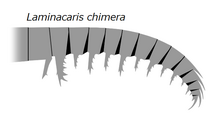用户:我是一只北极熊/刃刺虾属
| 奇美拉刃刺虾 | |
|---|---|

| |
| 刃刺虾的前附肢复原图 | |
| 科学分类 | |
| 界: | 动物界 Animalia |
| 门: | 节肢动物门 Arthropoda |
| 纲: | †恐虾纲 Dinocaridida |
| 目: | †放射齿目 Radiodonta |
| 科: | †地位未定 incertae sedis |
| 属: | †刃刺虾属 Laminacaris Guo et al.,2018 |
| 种: | †奇美拉刃刺虾 L. chimera
|
| 二名法 | |
| †Laminacaris chimera Guo et al.,2018
| |
| 其他物种[2] | |
| |
| 异名[3] | |
| |
奇美拉刃刺虾(学名:Laminacaris chimera)是刃刺虾属 (学名:Laminacaris)的唯一物种,也是模式种。属于节肢动物门、恐虾纲、放射齿目、地位未定的物种。[1]生活在中国寒武纪的海里。[4]除了在中国发现,也在美国宾夕凡尼亚州发现疑似该属的前附肢化石。[2]刃刺虾有著放射齿目里迄今最长的前附肢,也有可能是体长第二大的奇虾科、抱怪虫科类群的物种。[5][6][7]刃刺虾的前附肢有一些的特征是来自于放射齿目各科的型态[1][8],所以目前刃刺虾的分类与开拓虾属一样尚未分进任何科。[9][10]
发现
[编辑]刃刺虾的化石标本在在中国云南东部昆明筇竹寺地层(Chiungchussu Formation)玉案山段( Yu’anshan Member)发现的,且三个标本都是近乎完全保存了前附肢[1]:
- 在海口镇(Haikou area)的麻坊阶层(Mafang section)发现编号为RCCBYU 10251、YKLP 13338的标本。[1]
- 澄江市的凤口佋阶层(Fengkoushao section)发现编号为CJHMD 00003的化石标本。[1]
命名
[编辑]刃刺虾的属名Laminacaris是源于拉丁语的“lamina”,意思细薄的刀片,;“caris”的意思是“虾”,是恐虾纲常用学名的后缀。种加词“chimera”是指希腊神话的奇美拉,是一种由许多种物种部分拼凑起来的怪物,代表此物种前附肢的不同部分与许多放射齿目物种的相似之处。[1]
型态
[编辑]前附肢长度约11至28公分以上,是目前发现过最长的。总共有15节,其中有两节为连接头部以及剩馀的13节。[1]
第二个节腹侧末端有根刺,上面有一根更小的刺。剩馀的13节中,每节外观都类似长方形,且高比宽还要长。每节都会被三角形的节膜(membranous)隔开。除了第十五节,每节腹侧的中间点都有一根刺。刺的大小会轮流交替。第三节的刺最大,还稍微地靠近第二节的刺,且非常靠近,形成了独特的分叉。第三节的刺上有五较大的小刺,且小刺越往刺的末端越大,而在每个较大的小刺中间还有更小的刺。第三节的刺约在三分之二的部分还有根朝第一节的方向的小刺。第四到第十四节上的刺长度小于节的高度,整体看起来会逐渐往末端弯曲。刺上面的小刺从原本的五根缩减至四根,朝第一节方向也是只有一根。第五节与第七节的刺差不多,有可能还稍微大一点。第九节到第十五节的背侧末端都有向外突出,且向前弯曲的刺。在第十五节有一根在末端的刺,非常微小。[1]
生态
[编辑](Amplectobelua stephenensis)的前附肢捕食模拟图
(Anomalocaris canadensis)的前附肢捕食模拟图
刃刺虾应该是活跃的掠食者,透过尖锐前附肢上的刺适合将猎物分割,但也结合了奇虾科(Anomalocarididae)和抱怪虫科(Amplectobeluidae)的捕食方式。刃刺虾的前附肢有著粗壮的刺和末端外观似爪子的型态,透过较巨大的刺以及用后面的节来牢固地抓住猎物,这点与抱怪虫属(Amplectobelua)非常类似。节膜与大小交替的刺会使前附肢更加灵活,这点与奇虾(Anomalocaris)相似。[1]如果可以证明刃刺虾的型态是属于奇虾科和抱怪虫科中间,那代表此群体是以捕食者作为基本的摄食策略,为过滤浮游生物的另一种方法[1],例如筛虾属(Tamisiocaris)[8][11][12]、海神盔虾属(Aegirocassis)[11][13][14]。
分类
[编辑]最初侯先光等人,于2004年出版“The Cambrian Fossils of Chengjiang, China”一本书,此书提到发现刃刺虾的化石标本"RCCBYU 10251",但当时认为是帚刺侯氏虾的亲近种。[3]2014年,耶鲁大学的雅各布·温瑟尔(Jakob Vinther)等人最初画出了刃刺虾的前附肢复原图但是将其当成帚刺侯氏虾的亲近种。[8]直到2018年,由郭晋等人将此物种重新命名并发表。[1]
2019年,艾希特大学的史蒂芬·帕茨(Stephen Pates)和洛桑大学的古生物学家艾莉森·C·戴利(Allison C. Daley)发现在美国国立自然史博物馆的馆藏中发现两具于1979年产自金泽斯地层(Kinzers Formation)的化石(编号为USNM 213993/PA 394和 USNM 90827A/PA 393)可能为薄刃虾未定种(?Laminacaris sp.)的前附肢,而非德里克·布里格斯(Derek E.G. Briggs)所推定的宾州光滑虾相似种(Anomalocaris? cf. pennsylvanica),但是保存的不完整,前后的部分并未保存。[2]
目前关于刃刺虾属于哪一个科仍不确定,但大致类似于抱怪虫科与奇虾科的类群。而与抱怪虫属和兰氏虾属(Ramskoeldia)都有几个相似的点,例如:附肢的第一节有较大的刺,且第五节的刺长度略微大于第三内叶——这两者,尤其是后者通常被认为是抱怪虫科的特征。但是,小刺数量不是奇数或是柄节数量不是三等一些特点使得刃刺虾可能并非抱怪虫科的一员。[1]
对于最新的研究而言,刃刺虾属于最基干的抱怪虫科成员,或者位于(奇虾科-抱怪虫科)共祖的基干位置。[15]
资料来源
[编辑]- ^ 1.00 1.01 1.02 1.03 1.04 1.05 1.06 1.07 1.08 1.09 1.10 1.11 1.12 Guo, Jin; Pates, Stephen; Cong, Peiyun; Daley, Allison C.; Edgecombe, Gregory D.; Chen, Taimin; Hou, Xianguang. A new radiodont (stem Euarthropoda) frontal appendage with a mosaic of characters from the Cambrian (Series 2 Stage 3) Chengjiang biota (PDF). Papers in Palaeontology. 2018-08-13, 5 (1) [2024-01-01]. ISSN 2056-2799. doi:10.1002/spp2.1231. (原始内容存档 (PDF)于2024-01-01).
- ^ 2.0 2.1 2.2 Pates, Stephen; Daley, Allison C. The Kinzers Formation (Pennsylvania, USA): the most diverse assemblage of Cambrian Stage 4 radiodonts. dx.doi.org. 2019-01-31 [2024-01-01].
- ^ 3.0 3.1 Xianguag, Hou; Aldridge, Richard J.; Bergstrom, Jan; Siveter, David J.; Siveter, Derek J.; Feng, Xiang-Hong. Anomalocarididae (Phylum Uncertain) (Pages: 94-101):Anomalocaris saron. The Cambrian Fossils of Chengjiang, China: The Flowering of Early Animal Life The Cambrian Fossils of Chengjiang, China: The Flowering of Early Animal Life. John Wiley & Sons. 2008-04-15 [2024-01-01]. ISBN 978-0-470-99994-3. (原始内容存档于2024-01-01) (英语).
- ^ Zhang, Mingjing; Wu, Yu; Lin, Weiliang; Ma, Jiaxin; Wu, Yuheng; Fu, Dongjing. Amplectobeluid Radiodont Guanshancaris gen. nov. from the Lower Cambrian (Stage 4) Guanshan Lagerstätte of South China: Biostratigraphic and Paleobiogeographic Implications. Biology. 2023-04-11, 12 (4). ISSN 2079-7737. doi:10.3390/biology12040583.
- ^ Chen, Jun-yuan; Ramsköld, Lars; Zhou, Gui-qing. Evidence for Monophyly and Arthropod Affinity of Cambrian Giant Predators. Science. 1994-05-27, 264 (5163). ISSN 0036-8075. doi:10.1126/science.264.5163.1304.
- ^ Cong, Peiyun; Daley, Allison C.; Edgecombe, Gregory D.; Hou, Xianguang. The functional head of the Cambrian radiodontan (stem-group Euarthropoda) Amplectobelua symbrachiata. BMC Evolutionary Biology. 2017-08-30, 17 (1). ISSN 1471-2148. doi:10.1186/s12862-017-1049-1.
- ^ Wu, Yu; Pates, Stephen; Pauly, Daniel; Zhang, Xingliang; Fu, Dongjing. Rapid growth in a large Cambrian apex predator. National Science Review. 2023-11-03. ISSN 2095-5138. doi:10.1093/nsr/nwad284.
- ^ 8.0 8.1 8.2 Vinther, Jakob; Stein, Martin; Longrich, Nicholas R.; Harper, David A. T. A suspension-feeding anomalocarid from the Early Cambrian. Nature. 2014-03, 507 (7493). ISSN 0028-0836. doi:10.1038/nature13010.
- ^ Zeng, Han; Zhao, Fangchen; Zhu, Maoyan. Innovatiocaris, a complete radiodont from the early Cambrian Chengjiang Lagerstätte and its implications for the phylogeny of Radiodonta. Journal of the Geological Society. 2022-12-13, 180 (1). ISSN 0016-7649. doi:10.1144/jgs2021-164.
- ^ Moysiuk, J.; Caron, J.-B. A new hurdiid radiodont from the Burgess Shale evinces the exploitation of Cambrian infaunal food sources. Proceedings of the Royal Society B: Biological Sciences. 2019-08-14, 286 (1908) [2024-01-20]. ISSN 0962-8452. PMC 6710600
 . PMID 31362637. doi:10.1098/rspb.2019.1079. (原始内容存档于2022-12-12) (英语).
. PMID 31362637. doi:10.1098/rspb.2019.1079. (原始内容存档于2022-12-12) (英语).
- ^ 11.0 11.1 Lerosey-Aubril, Rudy; Pates, Stephen. New suspension-feeding radiodont suggests evolution of microplanktivory in Cambrian macronekton. Nature Communications. 2018-09-14, 9 (1). ISSN 2041-1723. doi:10.1038/s41467-018-06229-7.
- ^ Moysiuk, J.; Caron, J.-B. A new hurdiid radiodont from the Burgess Shale evinces the exploitation of Cambrian infaunal food sources. Proceedings of the Royal Society B: Biological Sciences. 2019-07-31, 286 (1908). ISSN 0962-8452. doi:10.1098/rspb.2019.1079.
- ^ Van Roy, Peter; Daley, Allison C.; Briggs, Derek E. G. Anomalocaridid trunk limb homology revealed by a giant filter-feeder with paired flaps. Nature. 2015-03-11, 522 (7554). ISSN 0028-0836. doi:10.1038/nature14256.
- ^ Edgecombe, Gregory D. Palaeontology: In a Flap About Flaps. Current Biology. 2015-06, 25 (12). ISSN 0960-9822. doi:10.1016/j.cub.2015.04.029.
- ^ Wu, Yu; Pates, Stephen; Liu, Cong; Zhang, Mingjing; Lin, Weiliang; Ma, Jiaxin; Wu, Yuheng; Chai, Shu; Zhang, Xingliang; Fu, Dongjing. A new radiodont from the lower Cambrian (Series 2 Stage 3) Chengjiang Lagerstätte, South China informs the evolution of feeding structures in radiodonts. Journal of Systematic Palaeontology. 2024-12-31, 22 (1). ISSN 1477-2019. doi:10.1080/14772019.2024.2364887 (英语).





